|
Report from
Europe
EU tropical wood imports rebound after record low
The EU imported tropical wood products worth €1.81bn in
2014, which represents a 3% increase over the ten-year
low of €1.76bn registered in 2013.
Between 2012 and 2013 imports had dropped sharply by
13.2 % and fell below the €2bn threshold for the first time.
Even with the slight recovery, the EU‟s 2014 tropical
wood imports did not even reach half of what they were
less than ten years ago (Chart 1).

The different product groups were showing mixed trends
last year. Mouldings and decking (+12.9 % to €200
million) as well as ※other§ products (+10.1% to €240
million) grew by double-figure percentages and sawn
wood also booked healthy growth of 5.5% to €663 million.
Imports of plywood (+2.2% to €201 million) and veneers
(+1.3 % to €166 million) climbed at a more moderate
pace. At the same time, however, tropical log imports
dropped again sharply, down 24.3% to €60 million. And
deliveries of flooring (-5.8% to €83 million) and
glulam/joinery (-3.8% to €200 million) were also lower
than in 2013.
Closer analysis of monthly and quarterly data indicates
that European tropical wood imports increased especially
towards the end of last year. In fact, throughout the first
quarter of 2014, imports were still lower than in the same
period of the previous year.
In the April to June period, imports then rose slightly over
the same quarter in 2013. The rate of growth remained
modest during the third quarter as well.
However, in the final quarter of the year the European
countries imported tropical wood products worth €469
million, which is 10.6% more than in the last quarter of
2013 (Chart 2).
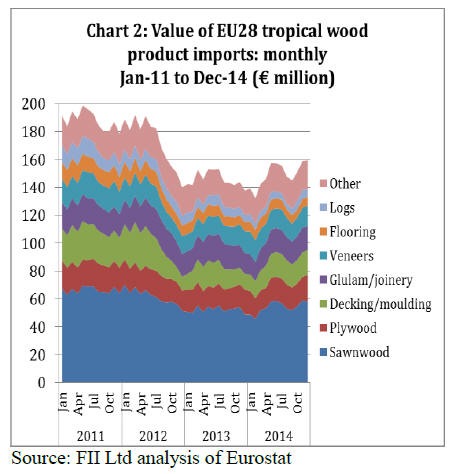
EU construction has firmed in 2014
The slight growth in European tropical wood imports last
year can be attributed to the continuing 每 if frequently
slow 每 recovery in several important sales markets. Most
notably the UK has reported strong demand for timber in
general and also for tropical wood products last year.
The Netherlands and Spain are showing signs of recovery
as well and Germany has remained stable at a satisfactory
level. France, on the other hand, has seen an economic
slow-down which led to a further contraction in
consumption of tropical timber last year.
These trends are also reflected in EU construction activity.
Chart 3 shows that the construction production value has
continued to pick up in several key markets during 2014,
even though the overall construction value throughout the
EU still remains clearly below pre-crisis levels.
Construction in the UK picked up strongly from the start
of 2013 and this trend continued throughout 2014.
However growth slowed at least temporarily at the
beginning of 2015. Construction value in France declined
slightly during 2014. The same is true for Portugal and
Italy.
On the other hand, construction in the Netherlands
continued its steady recovery last year. Spain has also
shown a steady uphill trend since the start of 2013,
although the recovery is from a very low level.
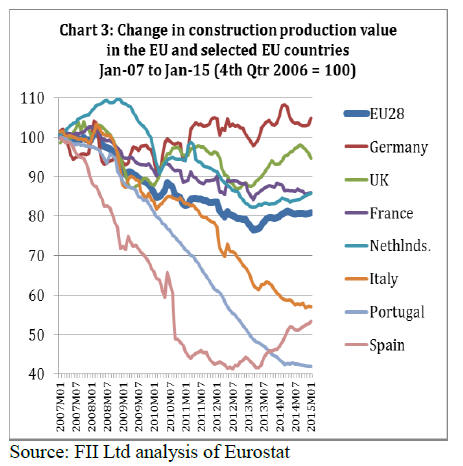
EU sawn tropical hardwood imports still lower than in
2012
The recent 5% increase in European sawn tropical
hardwood imports to 985,000 m3 was insufficient to offset
the 8% drop in deliveries experienced in 2013. A closer
look at the most important supplier countries reveals that
Malaysia (+13%), Brazil (+19%) and Ivory Coast (+15%)
boosted their deliveries to Europe significantly last year.
This came after decline in imports from these three
countries in 2013. Deliveries from the Congo Republic
and Gabon also continued their positive trend last year.
EU imports from Cameroon (-4%), Ghana (-9%) and
Indonesia (-8%) continued their downhill slide in 2014.
EU imports from the Democratic Republic of the Congo
fell by 3% in 2014 following an increase in 2013.

Chart 4 reveals that Cameroon remains by far the most
important supplier of sawn tropical hardwood to the EU,
despite the steep drop in 2013 and the renewed decline in
deliveries in 2014. The EU countries imported 302,000 m3
of tropical sawn timber from Cameroon in 2014, after
315,000 m3 in 2013 and 367,000 m3 in 2012.
The supply problems for sapele timber and associated long
lead times, the main cause for declining deliveries in 2013,
continued into 2014.
Moreover, shipments from Cameroon have been seriously
affected by logistical problems in the country‟s main port
of export in Douala. A strike at the port at the end of 2013,
as well as problems related to the depth of the port‟s
navigation channel, a broken loading crane and general
logistical problems caused a backlog of goods at the port.
According to information from importers, these problems
continue to persist for break bulk shipments and container
shipments are also occasionally subject to delay which
makes transportation times hard to calculate.
The new deep-water port in Kribi/Cameroon could help
ease this situation. The port is apparently operative now.
However, a European company that operates sawmills in
the region said in March 2015 that they had not yet
received any offers from the major shipping lines for
shipping from Kribi.
In 2014, Gabon was once again the second largest African
supplier of tropical sawn wood into Europe. European
demand for timber from Gabon had started to grow as
early as the end of last year. And throughout 2014 the
country‟s okoume exports remained rather competitively
priced compared to tulipwood from the USA, for example.
European imports from Ivory Coast also increased in
2014. This was due to strengthening demand for framire in
the UK combined with importers‟ increasing confidence in
legality assurance documentation.
In Malaysia, the second most important tropical sawn
wood supplier overall, prices for meranti lumber have
been comparatively low and stable throughout last year,
which may have fuelled demand.
Moreover, both the UK and the Netherlands, two of
Malaysia‟s largest European sales markets stepped up their
tropical timber imports last year (Chart 5). It total, the EU
countries imported 194,000 m3 of sawn timber from
Malaysia last year, 13% more than in 2013.
The anticipated drop in deliveries due to the change in
Malaysia‟s GSP status as of 1 January 2014 and related
rise in import duties from 3.5% to 7% has therefore not
materialised. Recognition of the Malaysian Timber
Certification System (MTCS) in the Dutch government
procurement policy in 2013 may have boosted sales in the
Netherlands during 2014.
The 19% increase in EU tropical sawn wood imports from
Brazil in 2014 has to be seen against the background of a
21% fall the previous year. At 118,000m3, last year‟s
tropical timber deliveries from Brazil still fell well short of
the 125,000m3 delivered back in 2012, before the EU
Timber Regulation entered into force.
The May 2014 Greenpeace report about alleged illegal
logging titled The Amazon‟s Silent Crisis has prompted
some European companies to take an even closer look at
their supply chains in Brazil. Nonetheless, European
tropical sawn wood imports from Brazil recovered last
year.
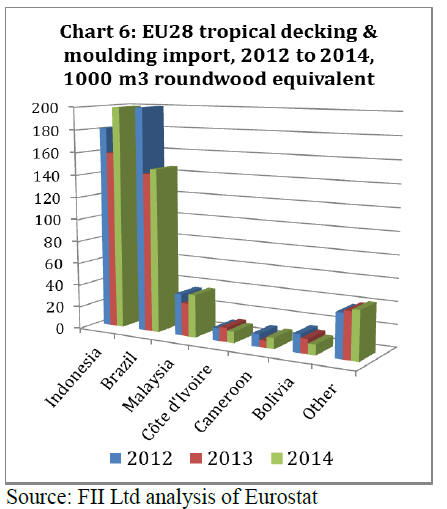
Recovery in EU decking and mouldings imports
Imports of ※continuously shaped§ wood (HS code 4409)
show a similar picture: after falling by 19% in 2013 they
rose again by 13% to 457,000 m3 in 2014. Continuously
shaped wood products listed under HS code 4409 include
both decking products and interior decorative products like
moulded skirting and beading.
Imports from the main supplier, Indonesia, in particular,
recorded a healthy trend and rose by 26% in 2014. The
same is true for imports from Malaysia, which recorded an
increase of 29%. Brazilian deliveries, on the other hand,
only rose by 3% after plummeting 30% the year before
(Chart 6).
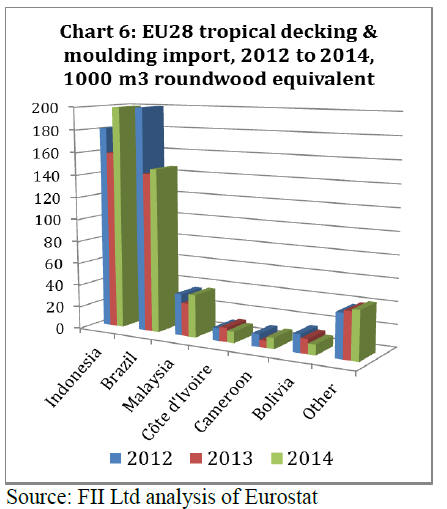
﹛
The European market for decking, both in general and for
tropical hardwood, recovered a little in 2014, after a
sluggish performance in 2013. Indonesian bangkirai
decking, in particular, regained market share last year, due
primarily to its competitive pricing. Prices for bangkirai
decking in Indonesia had dropped by around 20% between
2012 and 2014 and have not recovered since.
However, market insiders suggest that demand for other
tropical decking products increased more slowly and that
the overall market share of tropical timber in the decking
sector continued to decline in 2014.
Bangkirai products have tended to take market share from
other tropical timber decking 每 especially from Brazilian
products such as garapa, cumaru, or massaranduba 每 rather
than from other competing materials. The strongest growth
was again registered for Wood Plastic Composite decking
last year.
Window scantlings imports have grown but at a lower
value
Competition from other materials, mainly plastics but also
temperate hardwoods, continues to put pressure on the
EU‟s imports of tropical glulam, which consist primarily
of scantlings for the window sector. Imports in this
product group totalled 59,200 m3 last year, 6% more than
in 2013 but still 12.5% less than in 2012.
Moreover, the value of EU glulam imports from tropical
countries was down by 3.8% last year, in spite of the rise
in volumes, meaning that the average price of the imported
tropical window scantlings was lower than the year before.
Importers frequently mentioned a trend towards standardquality
meranti scantlings rather than the higher-quality
full log material last year, which may be an explanation
for the lower import value.
The rise in volumes was exclusively due to higher
deliveries from Indonesia (+10%) and Malaysia (+24%).
In 2014, these two countries delivered 23,500 m3 and
23,300 m3 respectively to the EU and together accounted
for roughly 79% of all EU imports of this commodity from
the tropics.
EU imports from all other significant tropical supply
countries declined last year, including Vietnam (-4%),
Singapore (-45%), Ivory Coast (-23%) and Ghana (-43%)
(Chart 7).
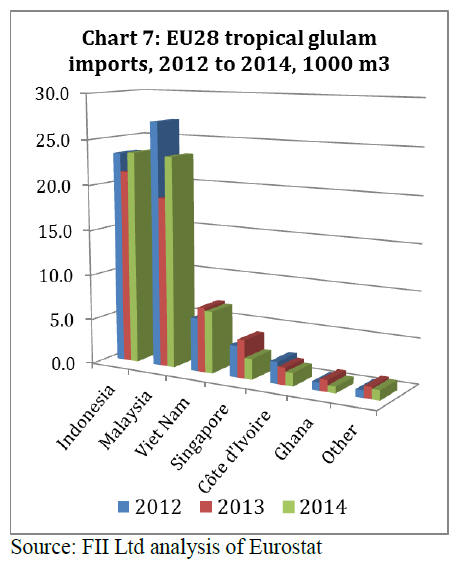
Flooring imports remain at a low level
EU imports of tropical wood flooring only showed a minor
increase by 2% to 4.17 million m2 last year, against the
very weak level reached in 2013. Compared to 2012,
import volume in 2014 was still down by 21.7%.
Moreover, the 2014 import value of €83 million was 5.8%
lower than in 2013 and 25.9% lower than in 2012.
Most European markets have seen a very strong trend
towards oak flooring in the last few years, which resulted
in lower demand for tropical timber. What is more, wood
in general has continued to lose market share to substitute
products such as Luxury Vinyl Tiles.
A closer look at the important supplier countries reveals
that the shift in flooring import volumes from Indonesia
towards Malaysia continued into 2014. Malaysian
deliveries recovered with a 7% increase last year, while
imports from Indonesia dropped by another 7%. In 2013
deliveries from both countries had declined, but Indonesia
experienced a much sharper fall (Chart 8).
Indonesia and Malaysia together account for the bulk of
the European tropical flooring imports. Of the other larger
supplier countries, Brazil (+6%), Vietnam (+20%) and
Peru (+88%) showed signs of improvement, while
deliveries from Thailand (-17%), Ivory Coast (-14%), and
Cameroon (-11%) continued to decline.
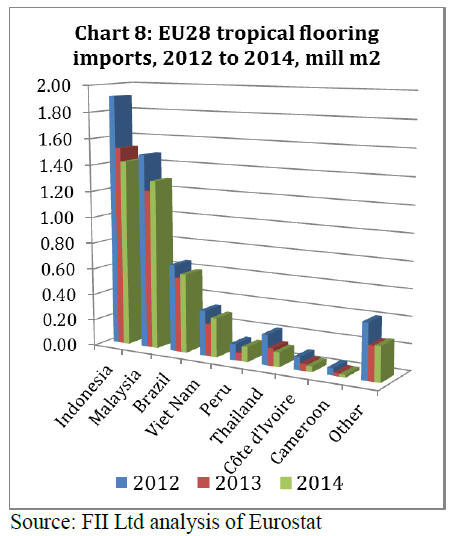
Tropical log exports plummeted again
Last year, as in previous years, EU imports of tropical
hardwood logs experienced the sharpest fall among all
tropical timber products. EU imports of 139,000 m3 in
2014were down 24% compared to 2013. Log imports have
declined steadily over the last ten years.
In terms of value, the EU‟s 2014 tropical log imports were
only worth 15% of those in 2004. Deliveries from all the
main supplier countries, with the exception of Equatorial
Guinea were down by double-figure percentages last year
(Chart 9).
Besides logistical restrictions and log export bans
instituted by various tropical countries including Gabon
and Myanmar in the last few years, this renewed decline is
probably also due to uncertainty over the reliability and
acceptance by EUTR competent authorities of
documentation for log exports from some regions.
This seems particularly true for the Democratic Republic
of the Congo, which saw its deliveries to Europe plunge
by 43% in 2014.
Environmental groups have shown a particular interest in
the Congo region since introduction of the EUTR,
resulting in the first major case in Germany when 57
wenge logs were seized by the country‟s competent
authority at the end of 2013. The case is not yet closed but
currently looks likely to end with the auctioning of the
wood by the German state.
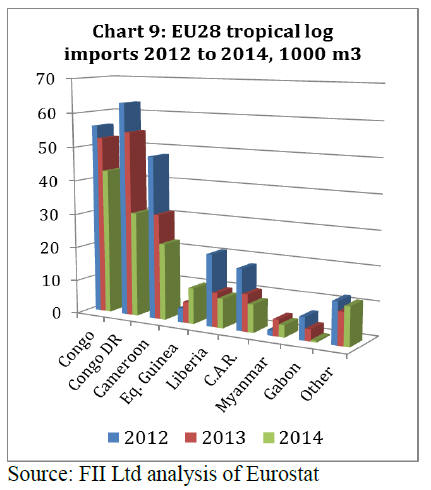
European importers are cautiously optimistic for 2015
European demand for various tropical timber products and
species in the first quarter of 2015 is described as
satisfactory to good by several importers. The UK market
remains good, even if demand in some instances is
reported to be slightly less buoyant than the same time last
year.
Some importers report signs of recovery in France and
Scandinavia. Some Eastern European markets, especially
Poland, are described as relatively active at the moment.
The German market is described as stable.
As regards the different products and regions of origin,
African timber, especially sapele, wawa, framire, and in
some European markets also sipo are in relatively strong
demand.
However, importers also report continuing difficulties in
sourcing enough timber in Africa. Framire is reported to
be very hard to get hold of at the moment and importers
suggest they could sell more if there were any extra
supply.
Sourcing of other African wood species is made difficult
by on-going logistical problems. European importers
suggest that truck shortages are causing delays in overland
transport in some parts of Africa. In addition to the abovementioned
delays in the port of Douala in Cameroon,
some importers also mention delays in shipping from
Pointe Noire in the Congo.
Competition for supply from Asian and American buyers
is mentioned as another challenge by European importers.
Some importers said the EUTR and related documentation
was still making it hard to compete with their Asian
counterparts, as African sawmills would frequently prefer
selling to Asia, where less documentation was required
and where customers are less picky when it comes to
specifications.
American buyers are also finding it relatively easy to
outbid their competitors from the Eurozone at the moment
due to the strong US dollar and the weakening euro value.
Demand for bangkirai and meranti from Indonesia and
Malaysia was also relatively good in February and March
of this year, as traders stocked up in anticipation of
exchange-rate related price hikes. Importers with large
inventories, who were able to offer material at mixed
prices, profited from this in particular.
A similar trend was observed for tropical timber from
South America. However, the costs of South American
tropical wood products had not only increased due to
unfavourable exchange rate trends but also due to price
hikes instituted by various producers at the end of last
year. As a result, importers report that they have been very
cautious in placing new orders for shipping this spring.
The strong US dollar represents a factor of uncertainty for
sales of tropical wood products traded in this currency in
the Eurozone. Whether sales will continue at their current,
satisfactory level will largely depend on future currency
trends as well as on suppliers‟ willingness to adjust prices.
The minor price concessions made by Indonesian and
Malaysian suppliers at the beginning of this year were
insufficient to offset the loss in value of the euro over the
last twelve months and in particular since December 2014.
Moreover, some importers expect those reductions to be
temporary in nature and that producers will go back to
their old prices in the next few weeks. On the other hand,
some sources believe that Brazilian producers may lower
their prices in the next few weeks, as the real has also
weakened against the US dollar.
|